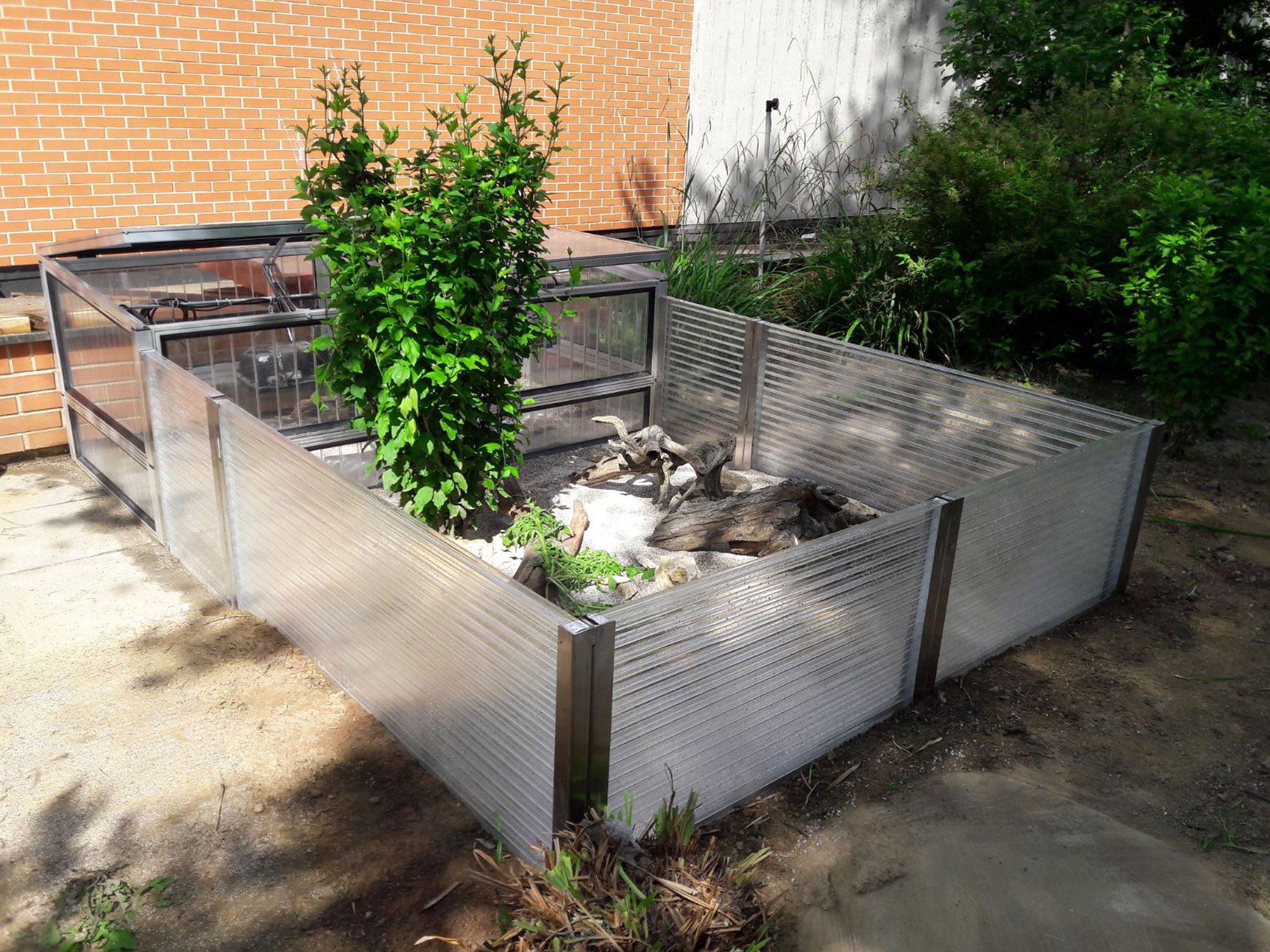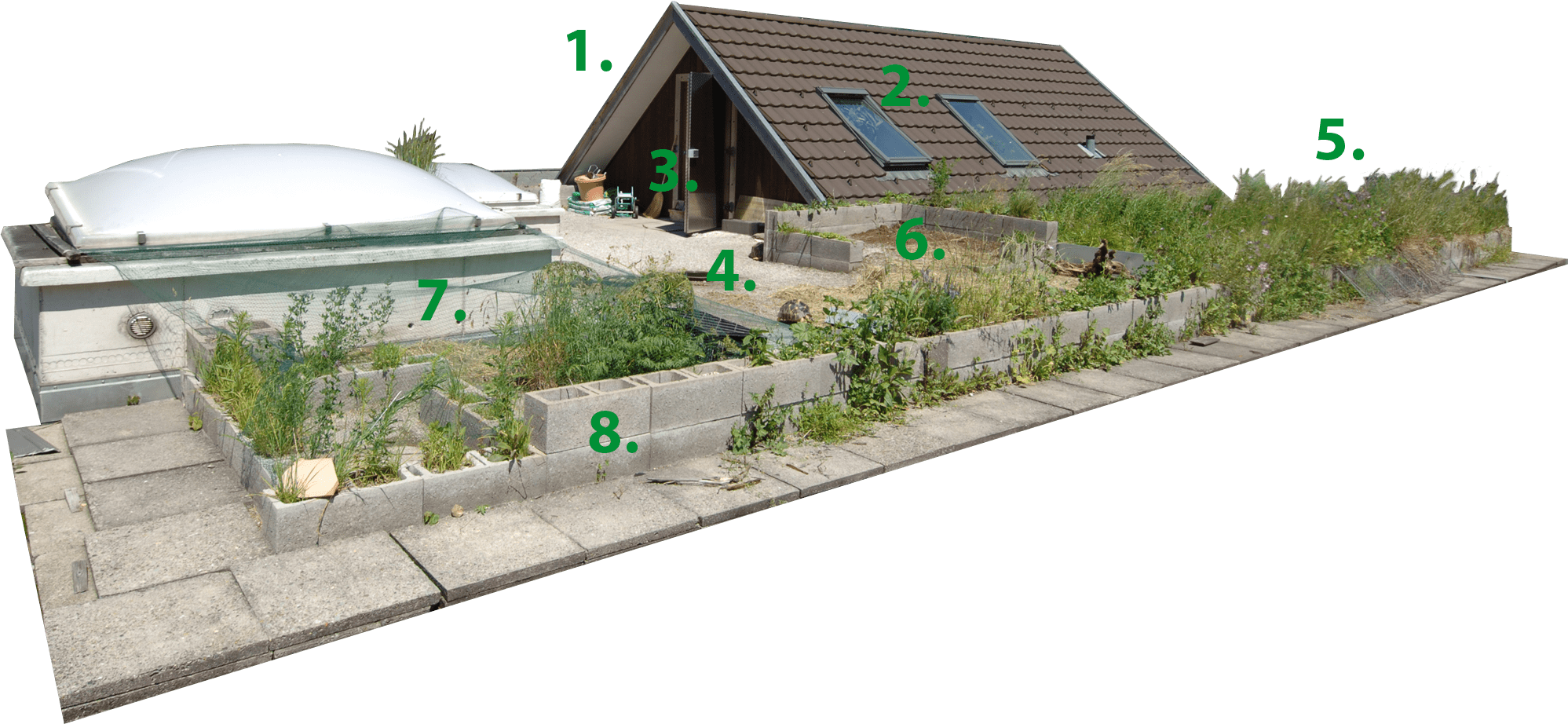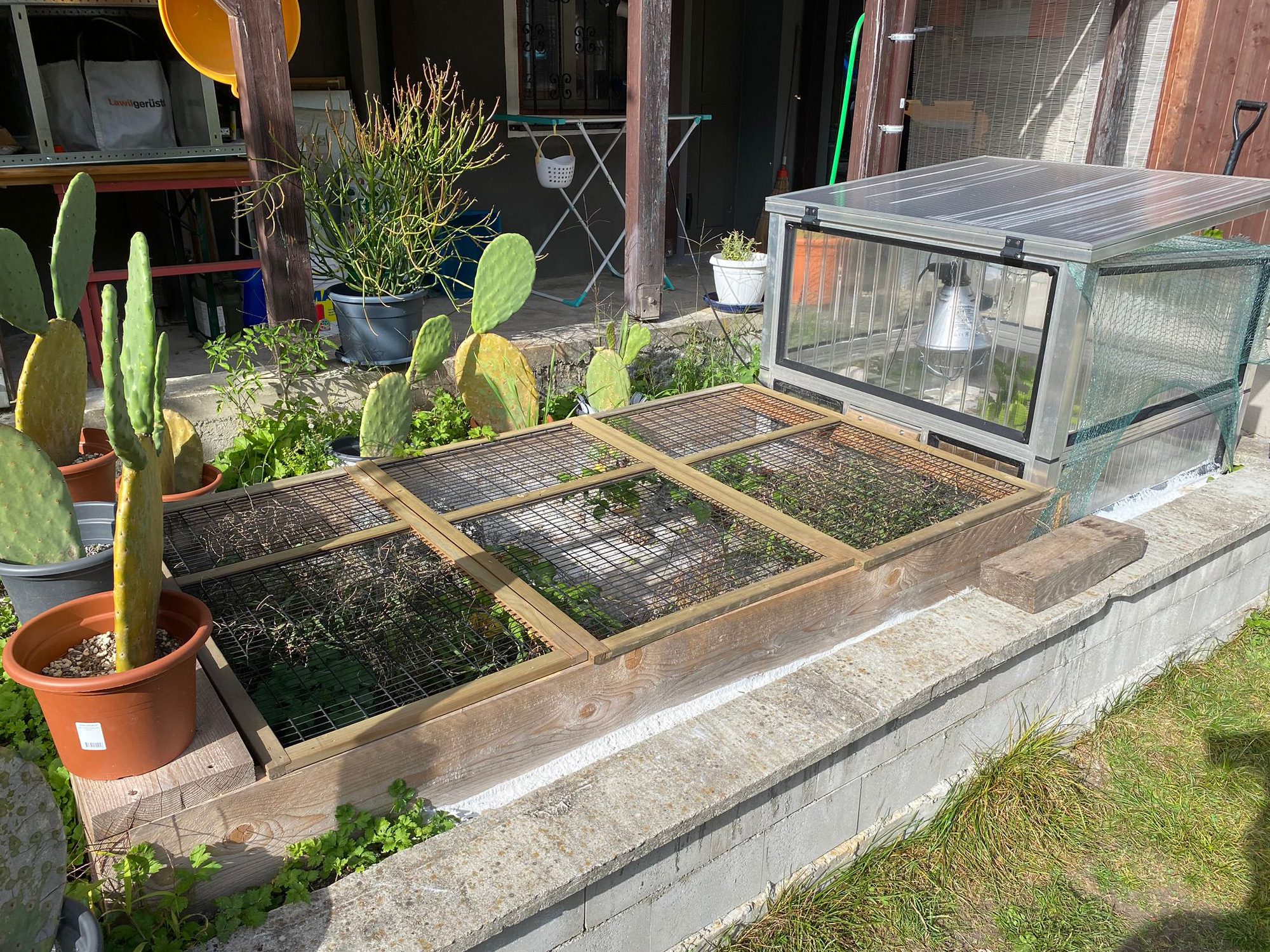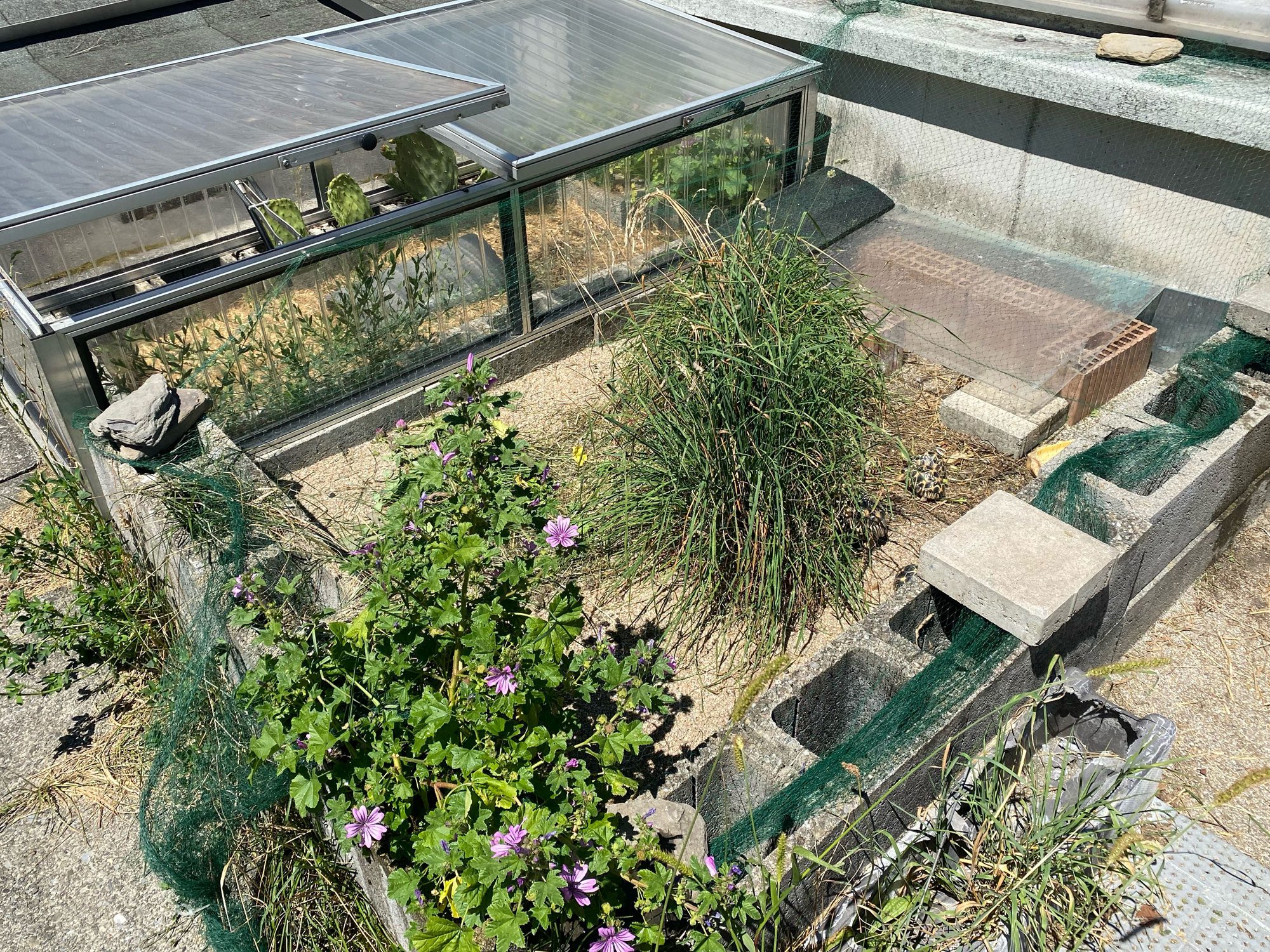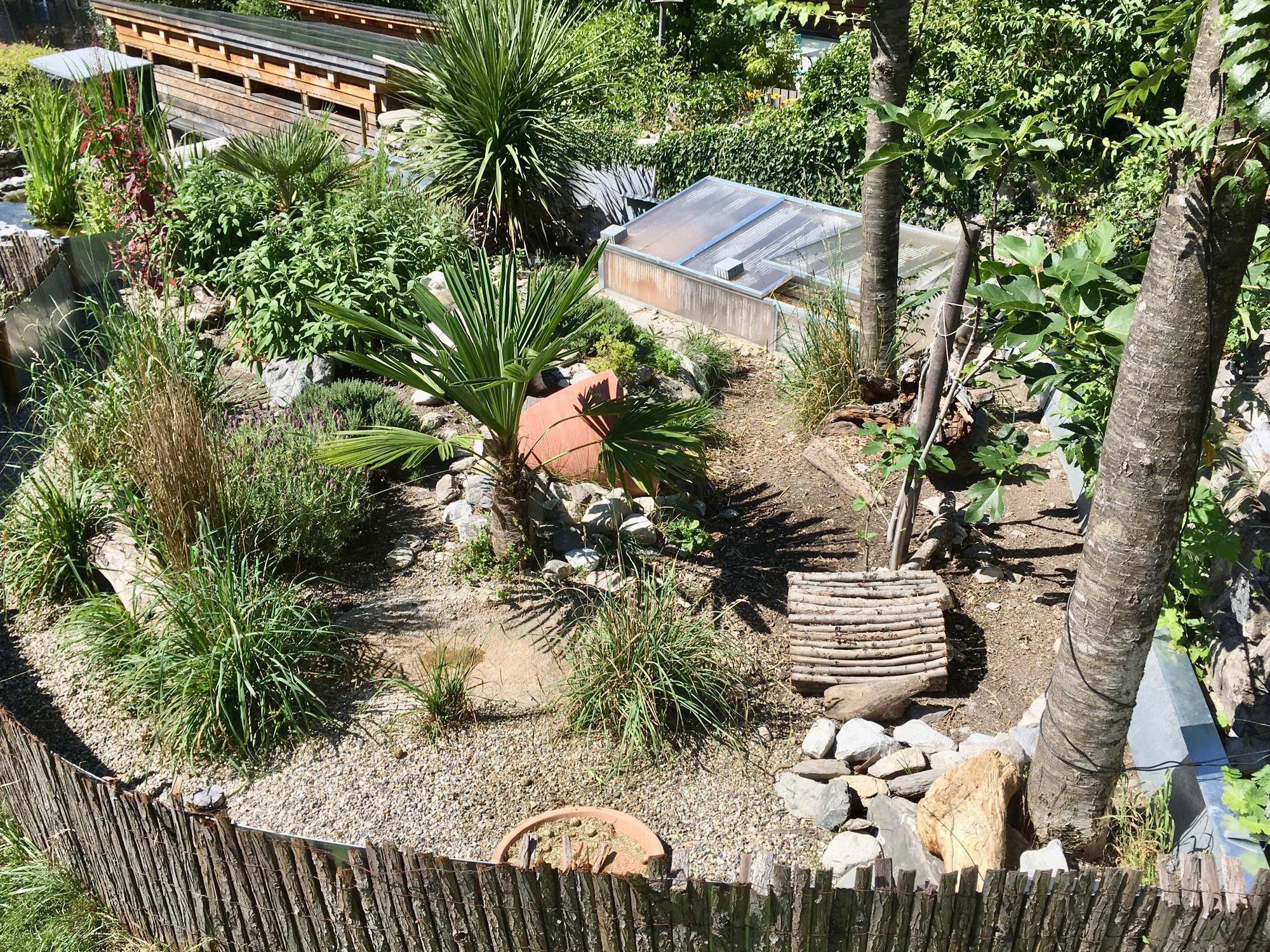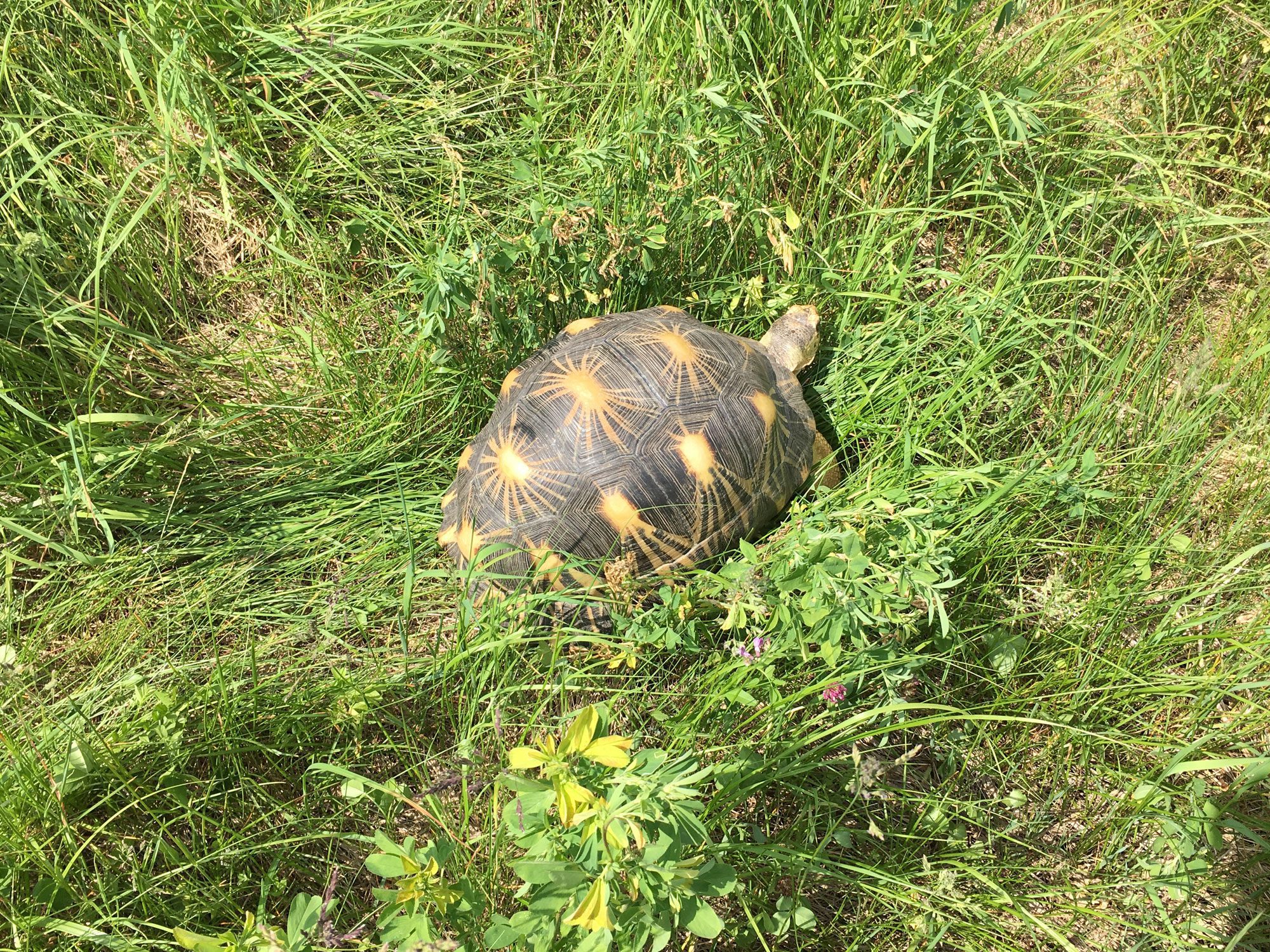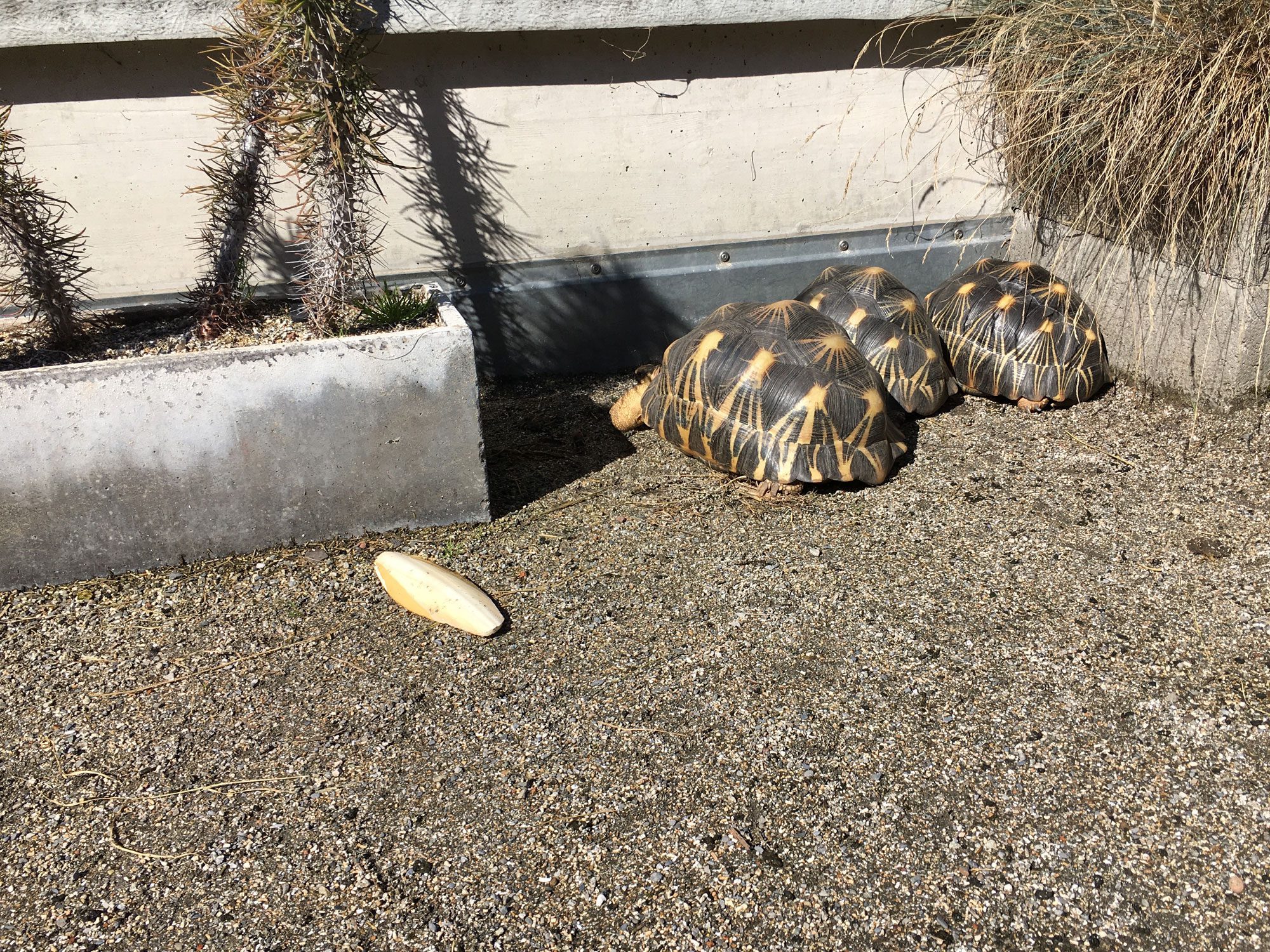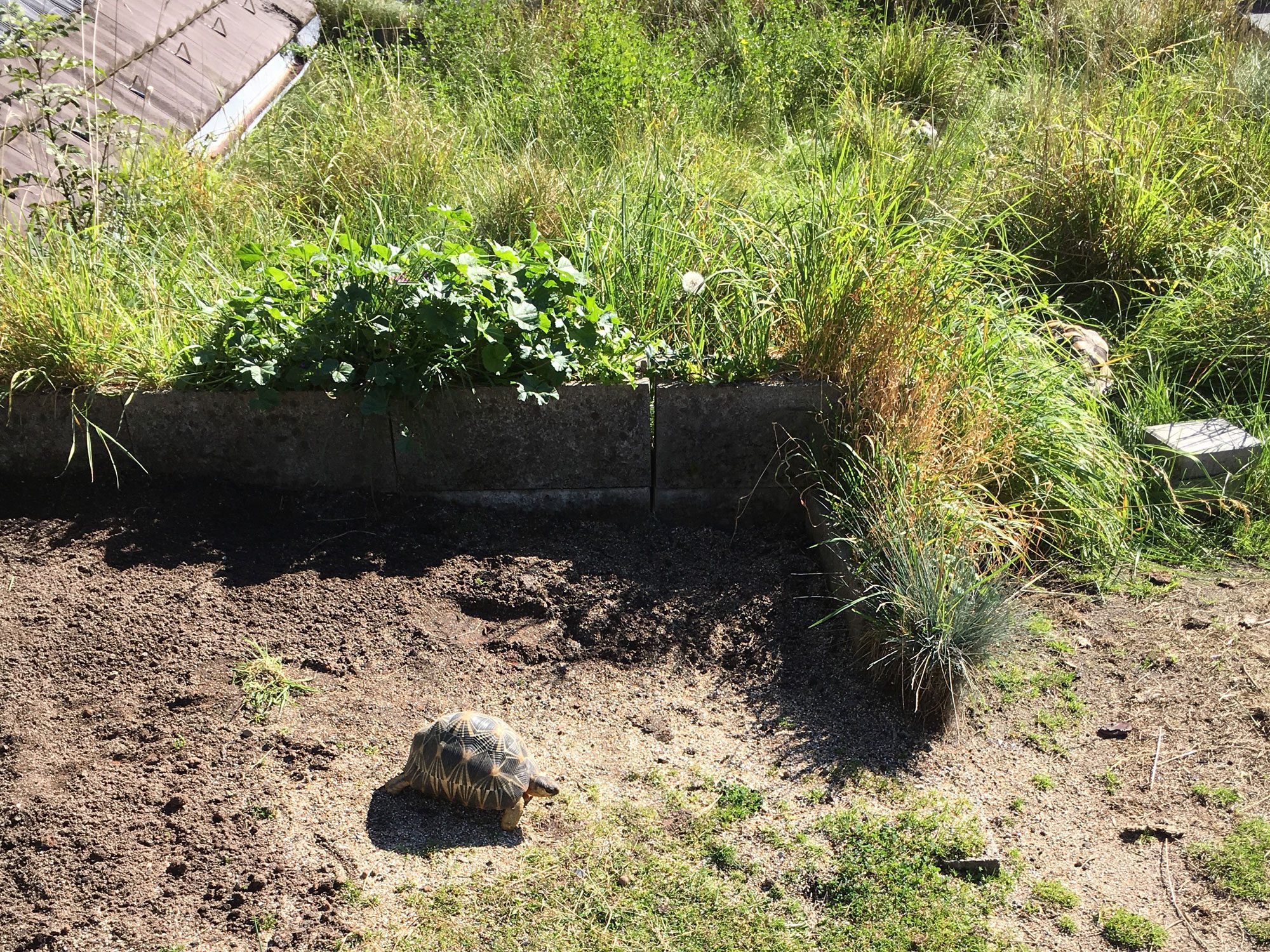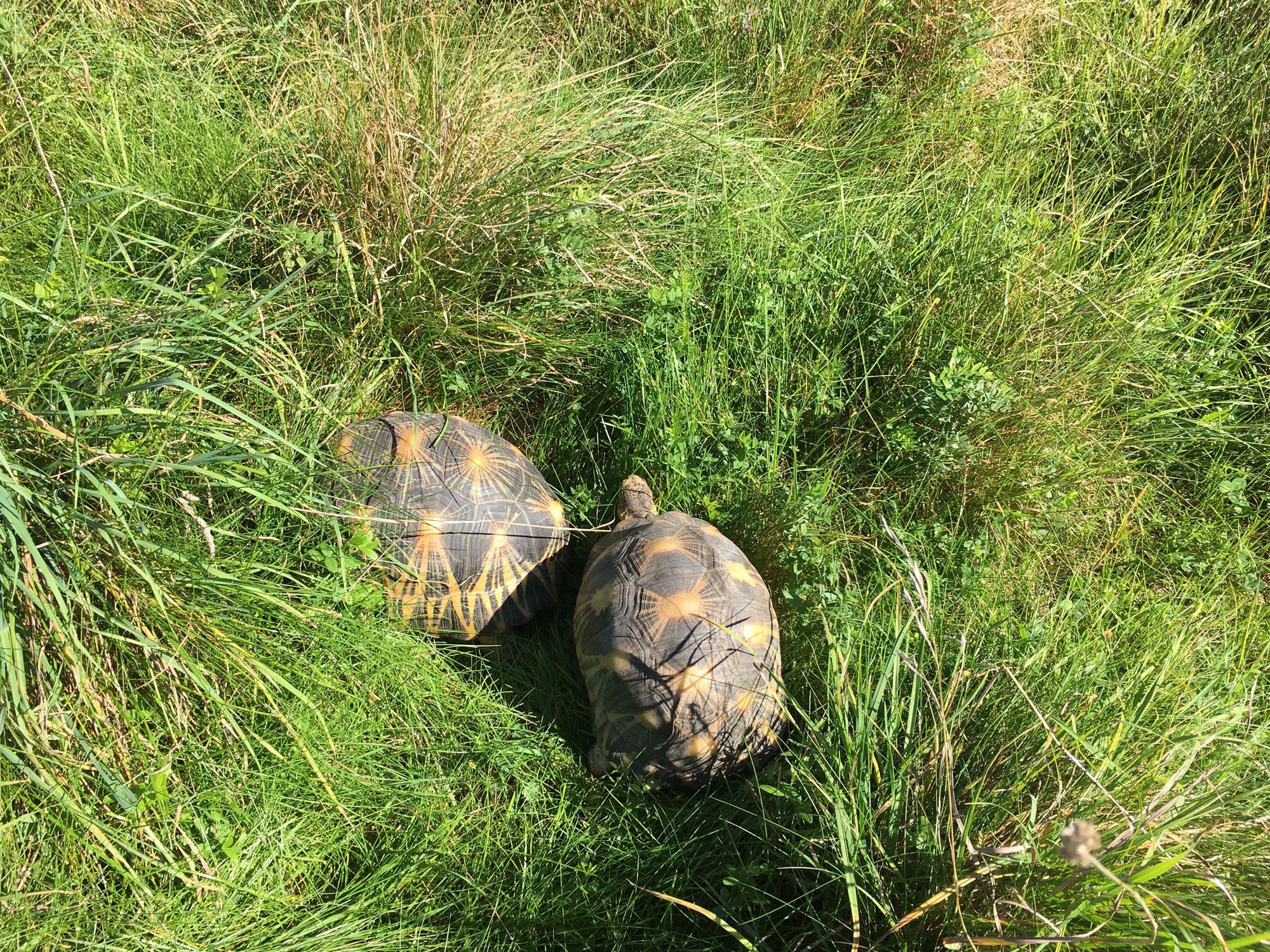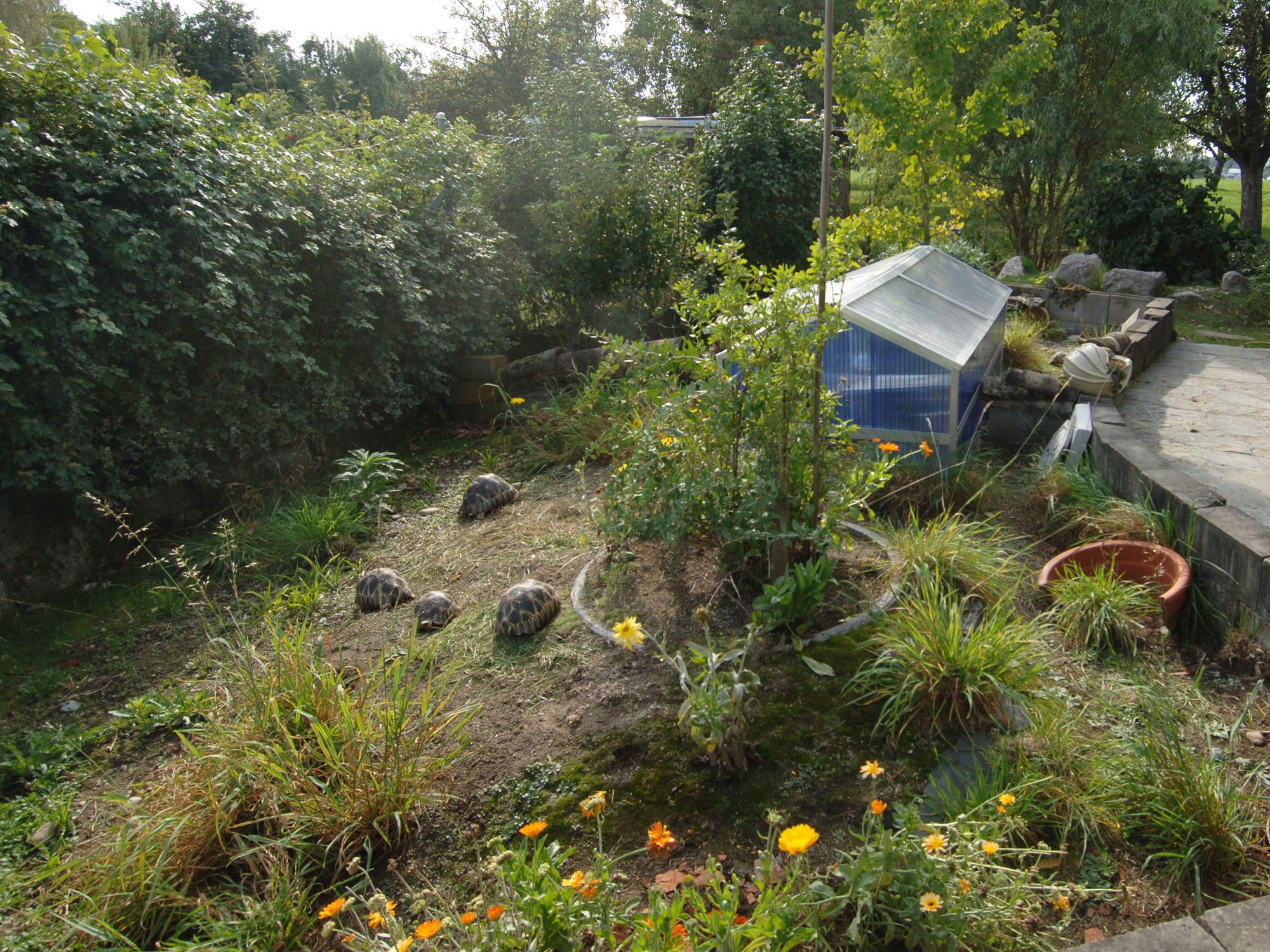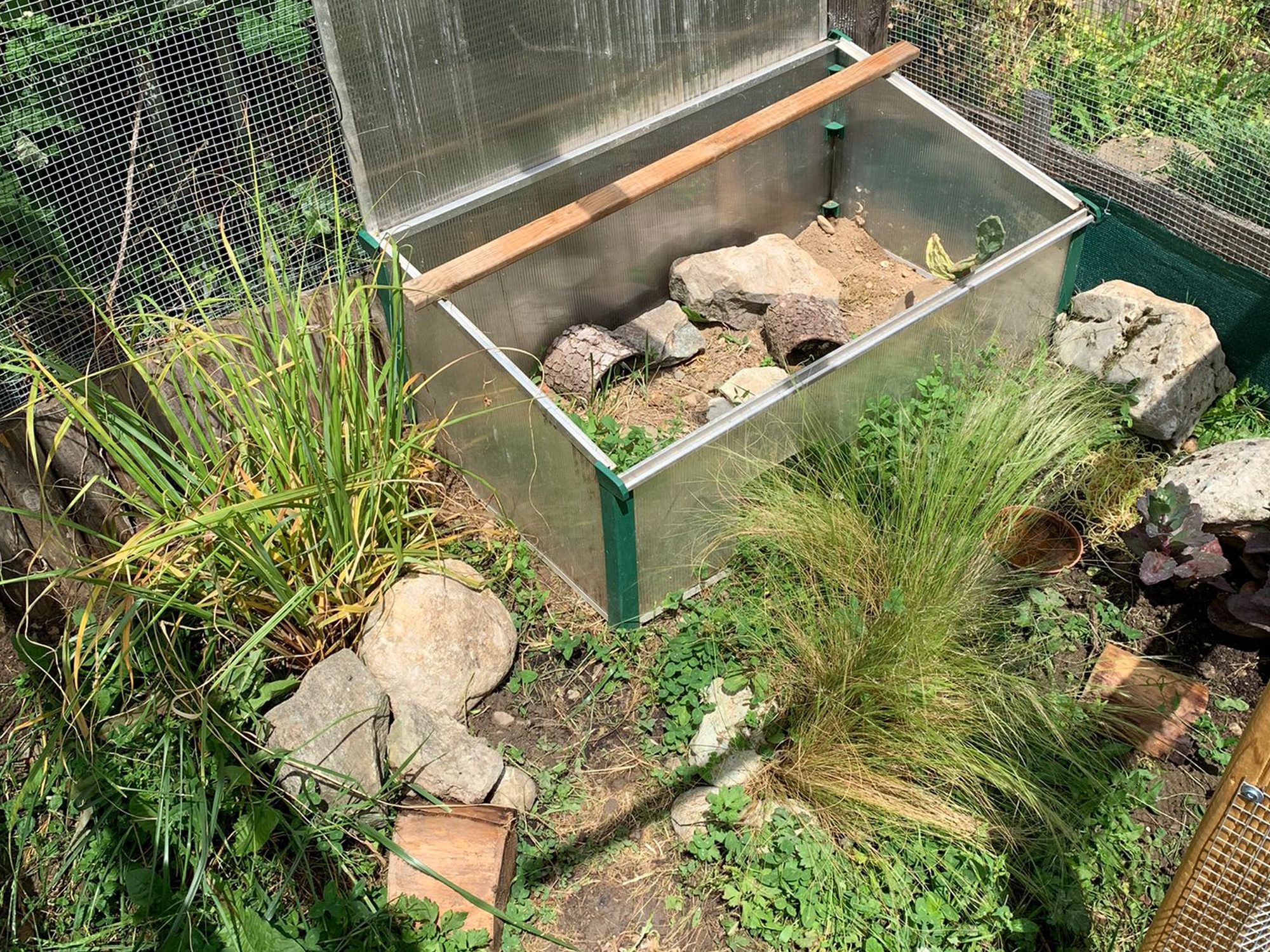Outdooranlagen
Schildkröten haben physische und psychische Bedürfnisse, die von uns Menschen in der Haltung oft völlig vernachlässigt werden. Schildkröten möchten sich sonnen, an der frischen Luft herumlaufen, nach Futter suchen, im Gelände weiden, sich verstecken und mit Artgenossen auf Schildkrötenart kommunizieren und interagieren. Dies alles ist in Indooranlagen meistens nur eingeschränkt möglich. Das ganze Repertoire an Schildkrötenbedürfnissen kann nur in naturnahen Aussenanlagen ausgelebt und befriedigt werden.
Wir können es nicht genug betonen: Eine Strahlenschildkröte gehört bei sonnigem Wetter immer in eine artgerechte Aussenanlage! Seien Sie grosszügig und bieten Sie ihrer Strahlenschildkröte an der sonnigsten Stelle im Garten ein naturnahes und gut strukturiertes Freilandgehege mit beheizbarer Schutzhütte. Sie wird es Ihnen mit Gesundheit und einem langen und glücklichen Schildkrötenleben danken!
Orientieren Sie sich bei der Gestaltung des Aussengeheges am natürlichen Biotop von Astrochelys radiata. Lichte, trockene und sonnige Sandflächen, die sich mit Graslandschaft und einer Bepflanzung mit niederem Buschwerk abwechseln, werden von Strahlenschildkröten bevorzugt. Das Gelände sollte grundsätzlich uneben, abwechslungsreich und gut strukturiert sein. Steine, Wurzeln, Äste und Baumstämme dienen den Schildkröten als Sichtschutz und Kratzgelegenheit. Eine Bepflanzung mit geeigneten Futterpflanzen ist nicht nur eine optische Verschönerung, sondern auch sehr praktisch.
Obwohl Strahlenschildkröten im Vergleich zu europäischen Landschildkröten weder gut klettern noch nennenswert graben, sind adulte Exemplare doch sehr kräftig und können mit ihrem Körpergewicht instabile und lockere Gehegeabgrenzungen leicht wegstemmen oder niederdrücken. Eine massive und robuste Abgrenzung des Freilandgeheges mit 40-50 cm hohen Löffelsteinen, Natursteinen, Beton-/Holzpalisaden oder anderen gemauerten Elementen ist sehr zu empfehlen. Maschenartige und transparente Einzäunungsmaterialen, ohne vollständigen Sichtschutz (Glas-, Gitter-, Drah-, Lattentzäune, etc.), irritieren Schildkröten in ihrer Grenzwahrnehmung und sind aufgrund der Verletzungsgefahr ungeeignet.
Schutzhäuser
Das Klima eines mitteleuropäischen Sommers ist für tropische Landschildkröten im Durchschnitt zu kalt, zu niederschlagsreich und weist definitiv eine zu geringe Sonnenscheindauer auf. Es muss deshalb im Outdoorbereich auf technische Hilfsmittel zurückgegriffen werden, um trockene, lichtdurchflutete Bereiche mit erhöhten Temperaturen zu schaffen. Ein Frühbeet oder ein Gewächshaus ist die einfachste Möglichkeit dies zu erreichen. Der Treibhauseffekt erhöht bei geringer Sonnenbestrahlung sofort die Temperatur, und eine gute Isolation sorgt dafür, dass sich die Wärme auch nachts bei kühlen Aussentemperaturen gut im Innern hält. Damit die lebenswichtigen UV-Strahlen täglich durch die Abdeckung hindurch zu den Schildkröten gelangen, sollte das ganze Schutzhaus komplett aus Alltop (Plexi-bzw. Acrylglas) bestehen. Bei Strahlenschildkröten ist es sinnvoll, trotz UV-durchlässiger Verglasung mit zusätzlichen UV-Strahlern zu arbeiten, um auch an bewölkten und regnerischen Tagen auf die notwendigen Licht- und Strahlungswerte zu kommen. Eine einfache Elektro- oder handelsübliche Gewächshausheizung sorgt während der nasskalten Übergangszeit für eine komfortable Basisitemperatur am Tag und in der Nacht. Wichtig ist die Installation eines einfachen, automatischen und öldruckbetriebenen Fensteröffners, der durch Anheben des Dachfensters für eine ausreichende Belüftung sorgt und einer Überhitzung des Frühbeetkastens vorbeugt. Je nach Grösse des Frühbeets oder des Gewächshauses sind, vor allem im Sommer, mehrere Lüfter nötig. Schutzhäuser können selber aus Alltopplatten gebaut oder in verschiedenen Grössen und Ausführungen bei den folgenden schweizer Anbietern gebrauchsfertig gekauft werden: Neogard, Botanicum, Frei
Mit HQI Leuchten und einer Heizung ausgestattete Frühbeete oder Gewächshäuser verlängern den Aufenthalt von tropischen Landschildkröten in unseren Breitengraden im Outdoorbereich um ein Vielfaches. Der Einsatz von Schutzhütten ist deshalb ein unverzichtbares Hilfsmittel in der Haltung von tropischen Landschildkröten.
Unsere Outdooranlage
Die gesamte nach Süden ausgerichtete Aussenanlage ist mit einer 50 cm hohen Mauer aus holen und bepflanzbaren Löffelsteinen eingezäunt und umfasst 100m2. Im Sommer wird die Aussenanlage bereits ab 8 Uhr von der Sonne beschienen. Die Anlage gliedert sich in zwei Bereiche, einen trockenen, sandigen Bereich und eine grüne Graslandschaft.
Der erste, trockne Bereich besteht aus einer sandigen und mit Muschelgrit durchsetzten Landschaft, auf der nur spärliche Vegetation gedeiht. Hier hat es flache Steine, kalkhaltiges Geröll und ein paar ausgegrabene Wurzelstöcke, die den Schildkröten als «Kratzbäume» dienen. Dieser Bereich trocknet nach Regenfällen immer rasch ab und wird gerne zum Sonnen und Aufwärmen aufgesucht. Während den Übergangszeiten, im Frühling und Herbst, verkleinern wir die Aussenanlage durch Abtrennen mit Holzbrettern auf diesen trockenen, sandigen Bereich. Von hier aus gelangen die Tiere auch selbständig über eine flache Rampe ins Innengehege. Weil das Innengehege direkt mit dem Aussengehege verbunden ist, und die Tiere selbständig entscheiden können, ob sie sich im geschützten Innenbereich oder im Freien aufhalten möchten, benötigen wir keine zusätzlichen Schutzhütten für die adulten Tiere.
Der zweite, grüne Bereich besteht aus einer künstlich angelegte Magerwiese, auf der allerlei Gräser und Kräuter gedeihen. Saisonal weiden die Strahlenschildkröten die gesamte Fläche komplett ab. Damit sich die Futterpflanzen erholen und nachwachsen können, trennen wir die Graslandschaft regelmässig wieder ab. Manche Kräuter werden aber derart abgefressen und ausgerupft, dass sie von Zeit zu Zeit wieder angesäht werden müssen. In diesem Weidebereich halten sich die Tiere auch gerne im Hochsommer auf und verkriechen sich mit Vorliebe unter grossen Grasbüscheln und schattigen Sträuchern. Während unserer Ferienabwesenheit achten wir darauf, dass die Magerwiese hoch steht und voll mit Futterpflanzen ist, so dass die Ferienvertretung keinen grossen Aufwand mit der Futterbeschaffung hat.
Sowohl im trockenen Bereich als auch in der Wiese hat es an den sonnigsten Stellen grosszügige, begrabbare Eiablageplätze für die Weibchen. Die Aussenanlage ist so konzipiert, dass einzelne Pärchen oder die Geschlechter untereinander abgetrennt werden können. Die kleineren Aussengehege der Jungtiere sind von dem Gehege der adulten Tiere abgetrennt. Für die Aufzucht der Jungtiere werden zusätzliche, beheizbare Schutzhütten aus Alltop benötigt.
Artgerechte Beispiele für Outdooranlagen
Im folgenden Bilderkarussel finden Sie zur Inspiration einige Beispiele und Impressionen von naturnahen und artgerechten Aussenanlagen für Strahlenschildkröten. Um für die Radiatacommunity eine breite und repräsentative Vielfalt an artgerechten Outdooranlagen zu zeigen, freuen wir uns sehr über das Zusenden von weiteren Bildbeiträgen. Alle Beiträge mit mindesten 2000 x 1500 Pixeln (Breite x Höhe) können gerne mit Namen und einem Copyright publiziert werden. Wir danken allen Strahlenschildkrötenhalter*Innen für ihre freundliche Unterstützung!
FAQ zum Themenbereich Freigehege
Strahlenschildkröten gehören in der warmen Jahreszeit, bei sonnigem und trockenem Wetter immer in ein Aussengehge! Unter der Voraussetzung, dass die Sonne scheint, sich das Aussengehege an einer Südlage befindet und die Tiere sich in einem beheizten Frühbeet oder Gewächshaus aufwärmen können, dürfen Strahlenschildkröten bereits ab 15°C Aussentemperatur ins Freigehege. Nur bei längeren Perioden mit nass-kalter Witterung und tiefen Temperaturen sollten sich Strahlenschildkröten ausschliesslich in beheizten, abgeschlossenen Schutzhäusern oder im Innengehege aufhalten.
Scheint die Sonne, lassen wir unsere Tiere bereits Anfang März für wenige Stunden ins Freigehege, damit sie ausgiebig UV Licht und frische Luft tanken können. Über Mittag hat es dann vielleicht milde Temperaturen von 15 bis 20°C. Manchmal liegt im Freigehege auch noch vereinzelt etwas Schnee, was die Tiere aber nicht zu stören scheint. Spätestens ab 16 Uhr müssen sich aber alle Tiere wieder im beheizten Schildkrötenhaus befinden. Die Nacht wird in den Übergangszeiten immer in einem beheizten und geschützten Innenraum verbracht!
Warme und trockene Sommer dürfen unsere Strahlenschildkröten Tag und Nacht im Freigehege verbringen. Im Hochsommer bleiben alle Licht- und Heizelemente in den Frühbeeten und im Innengehege ausgeschaltet. Die Dachklappen der Frühbeete für die Jungtiere stehen dann immer offen, um einer Überhitzung vorzubeugen. In Sommern mit tropischen Nächten verschliessen wir auch den Eingang zum Innengehege für die adulten Schildkröten, damit sie möglichst naturnah im Aussengehege unter Büschen übernachten können.
Um optimal vom natürlichen Sonnenlicht zu profitieren, versuchen wir auch im Herbst den Aufenthalt im Freigehege möglichst lange zu ermöglichen. Bleibt das Wetter sonnig und trocken, können Strahlenschildkröten tagsüber auch bis Ende Oktober Streifzüge im Freigehege unternehmen. Die Nächte sollten die Tiere dann aber immer in beheizten und verschlossenen Schutzhäusern verbringen. Spätestens wenn die Kraft der Sonne nachlässt, die Aussentemperaturen unter 15°C sinken und es zu andauernden, nass-kalten Wetterlagen kommt, müssen Strahlenschildkröten bis zum nächsten Frühjahr in das beheizte Winterquartier gebracht werden.
Diese Frage lässt sich nur sehr schwer beantworten, weil ein Gehege für ein Wildtier grundsätzlich nie gross genug sein kann. Wir bewundern und freuen uns immer sehr über die liebevolle Grosszügigkeit von einzelnen Schildkrötenhalter*Innen, die für ihre wenigen Tiere ganze Innenräume mit angrenzendem Garten zur Vefügung stellen und keine Kosten und Mühen für das Wohlbefinden Ihrer Schildkröten scheuen.
Strahlenschildkröten sind sehr aktive Schildkröten mit einem grossen Bewegungsbedarf. Als grobe Faustregel kann man davon ausgehen, dass die Masse für ein Innengehege mindestens 10x die Panzerlänge in der Länge und Breite betragen sollte. Für ein Aussengehege 20x die Panzerlänge in der Länge und Breite. Für jedes weitere Tier noch 2x die Panzerlänge in der Länge und Breite. Diese Angaben sollten nicht unterschritten werden! Natürlich müssen die Gehegegrössen mit dem Wachstum der Schildkröte immer wieder erweitert werden. Die Gehegegrösse sollte immer ausreichend gross gewählt werden, damit die Schildkröten verschiedene Licht- und Temperaturzonen darin vorfinden können.
Grundsätzlich sind Strahlenschildkröten Individualisten und streifen alleine und selbständig durch ihre jeweiligen Territorien. Dabei sind sie nicht auf permanente, dauerhafte, soziale Kontakte mit Artgenossen angewiesen. Saisonal, z.B. zur Paarungszeit oder an geeigneten Wasserstellen, Futter- bzw. Sonnenplätzen, treffen Strahlenschildkröten aber immer wieder auf Artgenossen und zeigen dann ein artspezifisches, interaktives Sozialverhalten. Für die Haltung in menschlicher Obhut bedeutet das, dass man Strahlenschildkröten über einen längeren Zeitraum und vor allem saisonal durchaus einzeln halten kann. Artgerecht wäre aber, wenn man ihnen ab und zu auch Kontakt zu Artgenossen ermöglicht. Astrochelys radiata ist eine eher friedliche Landschildkröte, so dass sowohl Männchen als auch Weibchen problemlos in kleinen Gruppen zusammen gehalten werden können. Bei einer Gruppenhaltung ist jedoch immer auf ausreichend Platz mit Ausweich- und Separationsmöglichkeiten zu achten! Im Hinblick auf die Arterhaltung, scheint das Anstreben von intakten Zuchtgruppen durchaus sinnvoll.
Schlüpflinge von Strahlenschildkröten rotten sich in den Aufzuchtbecken in Verstecken oft dicht zusammen, was manchmal den Eindruck erweckt, dass die Tiere auch die körperliche Nähe zu Artgenossen suchen. Ob Gruppenansammlungen von Jungtieren in freier Wildbahn, z.B. unter verottendem Laub in Trockenwäldern, auch vorkommen ist nicht bekannt. Dies könnte auch eher zufällig sein, weil gute, klimatisierte Verstecke auch in der Wildnis einfach beliebt und gefragt sind.
Achtung!: Obwohl Astrochelys radiata in den meisten Fällen eine gute soziale Verträglichkeit zeigt, raten wir dringend vor einer Vergesellschaftung mit artfremden Schildkröten ab! Astrochelys radiata hat eine besondere Überempfindlichkeit gegenüber bestimmten, artfremden Mikroorganismen. Werden diese im Übermass aufgenommen, kann es zur Verdrängung oder zum Absterben der Darmflora kommen. Das Immunsystem wird dadurch erheblich und nachhaltig geschwächt und es kann zu chronischen und schleichenden Entzündungen im Magen-Darmtrakt kommen. Diese Entzündungsherde können sich aber auch im ganzen Körper ausbreiten und zu einem generalisierten Organversagen führen. Vermutlich steht die geringe Toleranz von Astrochelys radiata gegenüber artfremden Mikroorganismen im Zusammenhang mit der endemischen Lebensweise und dem Bewohnen von einer ganz speziellen, begrenzten, ökologischen, Nische.
Kaufen Sie auch keine Schildkröten aus gemischtrassigen Beständen, denn diese könnten bereits mit diversen Karnkheitserregern infiziert sein! Beachten Sie, dass eine Vergesellschaftung unterschiedlicher Arten immer Ausdruck von beschränkten Platzverhältnissen und Ignoranz der individuellen Bedürfnisse darstellt. Eine Vergesellschaftung schaft neben einer erhöhten Kontaminationsgefahr auch zusätzlichen und unnötigen Stress für die Tiere.
Achtung!: Strahlenschildkröten stammen aus einer subtropischen Klimazone. Ihr Körper hat deshalb keine physische Anpassung und Voraussetzung um eine saisonale Kältestarre, wie sie z.B. europäische Landschildkröten abhalten, zu überleben. Der Versuch eine Strahlenschildkröte zu überwintern endet für das Tier tödlich! Bitte informieren Sie sich vor der Anschaffung ausführlich über die Bedürfnisse und Haltungsbedingungen dieser Tiere!

